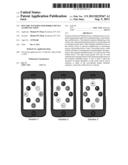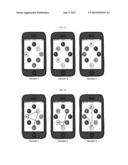Patent application title: Dynamic Patterns for Mobile Device Authentication
Inventors:
Michael W. Pinch (Rochester, NY, US)
IPC8 Class: AG06F3041FI
USPC Class:
345173
Class name: Computer graphics processing and selective visual display systems display peripheral interface input device touch panel
Publication date: 2013-09-05
Patent application number: 20130229367
Abstract:
Dynamic Patterns for Mobile Device Authentication is a
computer-implemented method for authenticating to and unlocking a mobile
device. The method comprises displaying a lock screen view with
randomized placement of colored nodes and or numbered nodes and or other
uniquely identified nodes on the mobile device to prevent unauthorized or
inadvertent access to the mobile device's data. The mobile device, while
locked, will detect a touch gesture corresponding to the placement of the
uniquely identified nodes on a touch screen of the mobile device. The
input touch gesture will vary for each authentication attempt based on
the randomized placement of the uniquely identified nodes. A user is able
to input the sequence of unique identifiers on the touch screen; and in
response to input of the user-defined unique identifier sequence, causes
the mobile device to unlock.Claims:
1. A computer-implemented method for authenticating to and unlocking a
mobile device, comprising: displaying a lock screen view with randomized
placement of colored nodes and or numbered nodes and or other uniquely
identified nodes on the mobile device to prevent unauthorized or
inadvertent access to the mobile device's data; while the mobile device
is locked: detecting a unique touch gesture corresponding to the
placement of the uniquely identified nodes on a touch screen of the
mobile device, wherein a user is able to input the sequence of unique
identifiers on the touch screen; and in response to input of the
user-defined unique identifier sequence, causes the mobile device to
unlock.Description:
CROSS REFERENCE TO RELATED APPLICATIONS
[0001] This nonprovisional utility patent application pertains to the invention described in and claims the benefit of Provisional Patent Application No. 61/606,441 filed on Mar. 4, 2012.
STATEMENT REGARDING FEDERALLY SPONSORED RESEARCH OR DEVELOPMENT
[0002] Not Applicable
REFERENCE TO SEQUENCE LISTING, A TABLE, OR A COMPUTER PROGRAM LISTING COMPACT DISC APPENDIX
[0003] Not Applicable
BACKGROUND OF THE INVENTION
[0004] 1. Field of the Invention
[0005] This field relates to dynamic pattern touch gesture authentication to a mobile device.
[0006] 2. Background Art
[0007] Some mobile devices, such as smart phones, include touch screens. These devices accept input by detecting movements, known as touch gestures, of fingers or other objects in contact with the touch screen. Upon detection of a touch gesture, the mobile device may execute an action.
[0008] Mobile devices generally include lock screens to prevent unauthorized or unintentional access to the device. Mobile devices running the Android operating system enable a user to define a touch pattern gesture from fixed nodes to unlock a touch screen. This feature, known as pattern unlock, enables a user to define a gesture to authenticate the user and unlock the device. However, the core issue with pattern-based systems used for authentication to mobile devices is that the excessive residue left behind on the touch screen allows an unauthorized user to follow the residue smudge on the screen to easily guess the pattern to unlock the device.
[0009] Systems and methods are needed that enable users to more securely access the functionality of a locked mobile device.
BRIEF SUMMARY OF THE INVENTION
[0010] Embodiments enable a user to unlock a mobile device by inputting a touch gesture of a predefined sequence of uniquely identified nodes on a lock screen. While the mobile device is locked, a randomized placement of colored nodes and or numbered nodes and or other uniquely identified nodes on the mobile device is presented to the user. The input touch gesture will vary for each authentication attempt based on the randomized placement of the uniquely identified nodes. A user is able to input the sequence of unique identifiers on the touch screen; and in response to input of the user-defined unique identifier sequence, causes the mobile device to unlock.
[0011] Further embodiments, features, and advantages of the invention, as well as the structure and operation of the various embodiments of the invention are described in detail below with reference to accompanying drawings.
BRIEF DESCRIPTION OF THE SEVERAL VIEWS OF THE DRAWING
[0012] The accompanying drawings, which are incorporated herein and form a part of the specification, illustrate the present invention and, together with the description, further serve to explain the principles of the invention and to enable a person skilled in the pertinent art to make and use the invention.
[0013] FIG. 1A is a drawing demonstrating three illustrative examples of display screens of a locked mobile device with randomized placement of uniquely identified nodes on the mobile device. These three examples are shown as Variation 1, Variation 2 and Variation 3. The uniquely identified nodes vary for each authentication attempt.
[0014] FIG. 1B is a drawing demonstrating the touch gestures the user would input in order to authenticate to the display screen with a randomized pattern. Variation 1, Variation 2 and Variation 3 correspond to the Variations in FIG. 1A.
DETAILED DESCRIPTION OF THE INVENTION
[0015] As mentioned above, the core issue with pattern-based systems used for authentication to mobile devices is the excessive residue left behind on the touch screen makes a fixed pattern easy for an unauthorized user to guess. A solution to this problem is to ensure a different pattern is entered on each screen. This pattern matching system assigns a unique color, number, or other unique identifier to each node, and randomizes the placement of the nodes on each login attempt. The nodes must be arranged in a pattern such that the user is able to access each node from any point on the screen. In order to authenticate, the user would remember their unique identifier sequence.
[0016] Dynamic Patterns for Mobile Device Authentication is a computer-implemented method for authenticating to and unlocking a mobile device. The method comprises displaying a lock screen view with randomized placement of colored nodes and or numbered nodes and or other uniquely identified nodes on the mobile device to prevent unauthorized or inadvertent access to the mobile device's data. The mobile device, while locked, will detect a touch gesture corresponding to the placement of the uniquely identified nodes on a touch screen of the mobile device. The input touch gesture will vary for each authentication attempt based on the randomized placement of the uniquely identified nodes. A user is able to input the sequence of unique identifiers on the touch screen; and in response to input of the user-defined unique identifier sequence, causes the mobile device to unlock.
[0017] A summary of rules for this authentication method is listed in paragraphs 0020 through 0025.
[0018] Unlock screen will display a randomized pattern of uniquely identified nodes.
[0019] Nodes must be arranged in a pattern such that the user is able to access each node from any point on the screen.
[0020] User-defined authentication sequence must be a minimum of 4 nodes.
[0021] Nodes may be selected any number of times; however no node may be visited twice consecutively.
[0022] User inputs their pre-defined authentication sequence by selecting nodes displayed on the unlock screen.
[0023] Correct entry sequence of unique identifiers on the unlock screen will cause the device to unlock.
[0024] FIG. 1A is a drawing demonstrating three illustrative examples of display screens of a locked mobile device with randomized placement of uniquely identified nodes on the mobile device. These three examples are shown as Variation 1, Variation 2 and Variation 3. The uniquely identified nodes vary for each authentication attempt. Variations 1 is an illustrative example of unique identifier locations on the authentication screen for log in attempt one, Variation 2 is an illustrative example of unique identifier locations on the authentication screen for log in attempt two, and Variation 3 is an illustrative example of unique identifier locations on the authentication screen for log in attempt three. Node unique identifiers could be colors, numbers, letters, symbols, or any combination thereof.
[0025] FIG. 1B is a drawing demonstrating the touch gestures the user would input in order to authenticate to the display screen with a randomized pattern. Variation 1, Variation 2 and Variation 3 correspond to the Variations in FIG. 1A. In order to authenticate, the user would remember their sequence of unique identifiers. In an example where a user has defined their pass code to be R, W, Y, B, this figure uses arrows to indicate the touch gesture input required by the user to authenticate to the mobile device depending on the location of the R, W, Y, and B nodes.
User Contributions:
Comment about this patent or add new information about this topic:
| People who visited this patent also read: | |
| Patent application number | Title |
|---|---|
| 20130228672 | LINE MEMORY DEVICE AND IMAGE SENSOR INCLUDING THE SAME |
| 20130228671 | CMOS SENSOR ARRAY |
| 20130228670 | PHOTOELECTRIC CONVERSION ELEMENT UNIT AND IMAGE PICKUP APPARATUS |
| 20130228669 | MOUNTING APPARATUS FOR FAN |
| 20130228668 | BICYCLE SEAT WITH RESILIENT SUPPORT |


